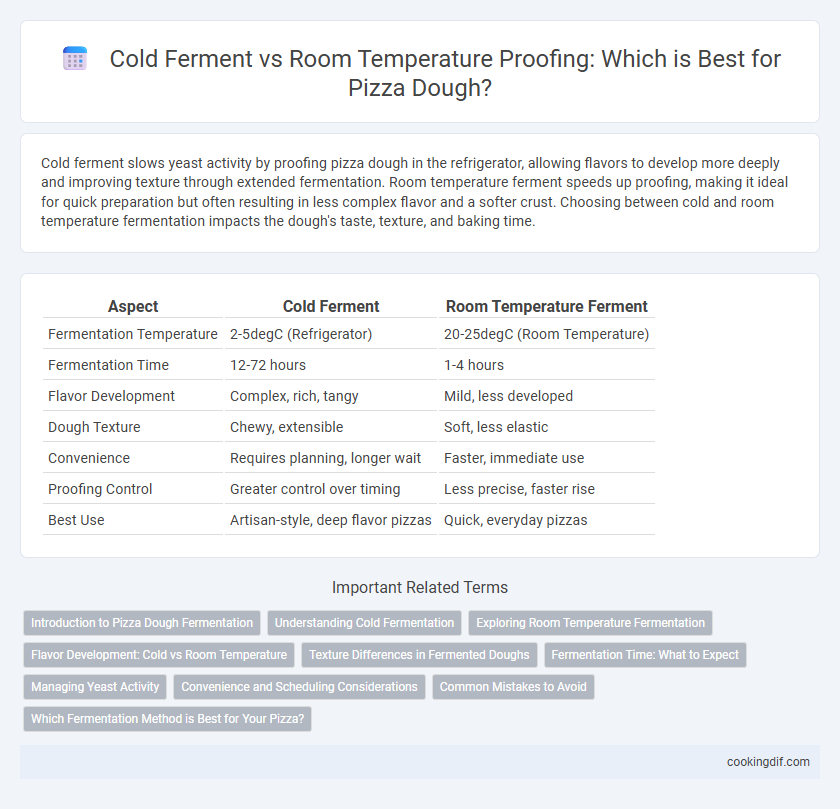Cold ferment slows yeast activity by proofing pizza dough in the refrigerator, allowing flavors to develop more deeply and improving texture through extended fermentation. Room temperature ferment speeds up proofing, making it ideal for quick preparation but often resulting in less complex flavor and a softer crust. Choosing between cold and room temperature fermentation impacts the dough's taste, texture, and baking time.
Table of Comparison
| Aspect | Cold Ferment | Room Temperature Ferment |
|---|---|---|
| Fermentation Temperature | 2-5degC (Refrigerator) | 20-25degC (Room Temperature) |
| Fermentation Time | 12-72 hours | 1-4 hours |
| Flavor Development | Complex, rich, tangy | Mild, less developed |
| Dough Texture | Chewy, extensible | Soft, less elastic |
| Convenience | Requires planning, longer wait | Faster, immediate use |
| Proofing Control | Greater control over timing | Less precise, faster rise |
| Best Use | Artisan-style, deep flavor pizzas | Quick, everyday pizzas |
Introduction to Pizza Dough Fermentation
Cold fermenting pizza dough involves proofing at low temperatures, typically between 35degF to 45degF, for 24 to 72 hours, which enhances flavor complexity and dough extensibility by slowing yeast activity. Room temperature fermentation occurs around 70degF to 75degF, reducing proofing time to 1 to 4 hours, but can result in less developed flavor and texture. Selecting cold or room temperature fermenting methods depends on desired dough characteristics, fermentation duration, and workflow preferences in pizza preparation.
Understanding Cold Fermentation
Cold fermentation involves proofing pizza dough at temperatures between 1degC and 5degC (34degF to 41degF) for 24 to 72 hours, allowing yeast activity to slow down and develop complex flavors and improved dough texture. This method enhances gluten strength and produces a more aromatic crust compared to room temperature fermentation, which typically occurs around 20degC to 24degC (68degF to 75degF) over 1 to 3 hours. Cold fermentation also provides greater control over fermentation time and dough development, resulting in better extensibility and a more balanced rise.
Exploring Room Temperature Fermentation
Room temperature fermentation accelerates yeast activity, typically requiring 4 to 6 hours for dough to double in size, making it ideal for same-day pizza preparation. This method enhances gluten development and flavor complexity by maintaining an optimal environment between 70degF and 75degF (21degC to 24degC). Compared to cold fermentation, room temperature proofing yields a softer crust with less tang, catering to pizzas needing quicker turnaround times.
Flavor Development: Cold vs Room Temperature
Cold ferment enhances flavor development by allowing yeast to work slowly over 24 to 72 hours, producing complex acids and aromatic compounds, resulting in a richer, more nuanced pizza crust. Room temperature ferment speeds up yeast activity within 1 to 3 hours, yielding a milder flavor profile with less depth but a softer texture. The extended enzymatic and microbial activity in cold fermentation is key for achieving a distinctive, well-rounded taste preferred by artisanal pizza makers.
Texture Differences in Fermented Doughs
Cold fermenting pizza dough slows yeast activity, resulting in a dough with enhanced gluten development and a chewier, more complex texture. Room temperature fermenting produces a faster rise, leading to a softer, airier crust with larger air bubbles and a lighter crumb. The choice between cold and room temperature fermentation significantly impacts the dough's elasticity, crust crispness, and overall mouthfeel.
Fermentation Time: What to Expect
Cold fermentation for pizza dough typically requires 24 to 72 hours, allowing yeast to slowly develop complex flavors and a chewier texture. Room temperature fermentation usually completes in 1 to 3 hours, producing a more immediate rise but less depth in taste. Extended cold fermentation enhances dough extensibility and crust crispness, while shorter room temperature proofing emphasizes quicker preparation.
Managing Yeast Activity
Cold ferment slows yeast activity by maintaining dough at temperatures around 38degF (3degC), resulting in a longer, more controlled proofing process that enhances flavor complexity and dough texture. Room temperature ferment accelerates yeast activity at approximately 70degF (21degC), producing a faster rise but less nuanced taste and a softer crust. Managing yeast activity through controlled fermentation temperature optimizes dough elasticity, gas production, and overall pizza quality.
Convenience and Scheduling Considerations
Cold fermenting pizza dough slows yeast activity by refrigerating it for 24 to 72 hours, allowing for flexible scheduling and deeper flavor development without immediate baking. Room temperature fermentation, occurring within 1 to 3 hours, suits quick meal prep but requires precise timing to avoid overproofing and loss of texture. Choosing between the two depends on balancing convenience with your available time and desired dough characteristics.
Common Mistakes to Avoid
Cold ferment slows yeast activity, allowing complex flavor development but requires extended time and consistent refrigeration to prevent overproofing or spoilage. Room temperature ferment speeds up proofing but risks uneven rising, overproofing, or dough drying if left unattended or exposed to drafts. Avoid common mistakes like insufficient fermentation time for cold ferment or excessive heat exposure for room temperature ferment to ensure optimal dough texture and flavor.
Which Fermentation Method is Best for Your Pizza?
Cold fermentation enhances flavor development by allowing the dough to rest in the refrigerator for 24-72 hours, creating a complex, tangy taste and improved texture. Room temperature fermentation speeds up the proofing process, typically taking 1-3 hours, resulting in a softer, lighter crust with less pronounced flavor. Choosing between cold and room temperature fermentation depends on your preferred flavor intensity, texture, and available proofing time.
Cold ferment vs room temperature ferment for proofing Infographic

 cookingdif.com
cookingdif.com